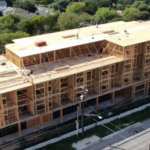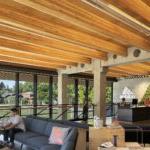Expert Tips
Roles and Responsibilities: Structural Design of Modular Projects
An overview of structural engineering roles for modular wood construction

The relationship between a Structural Engineer of Record (SEOR) and Specialty Structure Engineer (SSE) is understood for most traditional construction situations, but modular projects have some unique considerations and opportunities for collaboration.
With most construction projects, the SEOR can designate that structural components be “designed by others” or delegated to a fabricator’s engineer. In these cases, an SSE is retained by the fabricator to undertake the engineering and detailing of these “deferred” structural components. Section 107 of the 2021 IBC defines the roles of the SEOR and SSE with regard to construction documents and deferred submittals.
There are several reasons an SEOR may choose to delegate the full design and detailing of a structural component to a fabricator’s engineer—for example, to more fully utilize the fabricator’s design and manufacturing efficiencies. Common uses of delegated design include metal plate connected wood trusses, precast concrete, and steel stair assemblies. In some cases, these components are proprietary to the manufacturer or fabricator.
Modular Construction and Delegated Design
Modular construction is a great example of a delegated design condition. However, there are numerous situations where roles and responsibilities of the SEOR and SSE may overlap, driving the need for clear coordination between the design team and construction trades. Since the modular construction scope is such a large percentage of a building’s volume, this coordination is critical.
For example, modular construction typically has a definite horizontal plane separating the modular portion of the project from the portion built on site. This horizontal plane is often located where the base-level modular unit meets the foundation, and consists of a crawl space or slab-on-grade. In other cases, the horizontal plane is located between the base-level modular unit and a concrete podium.
In the simplest situation, the SEOR would be responsible for designing the portion of the building below the horizontal plane, while the modular manufacturer would be responsible for everything above the horizontal plane. In other conditions—e.g., if there are vertical planes between these scope separations or rooftop features outside the modular scope—the separation of design responsibilities may be more complex.
A less common approach is to have the same structural design team responsible for both the SEOR and SSE scope. The critical difference is that the structural team must be proficient in site-built design components as well as the modular manufacturer’s internal systems and processes—including fabrication process, modular unit set process, and component preferences. It is highly recommended that this expertise be developed through the observation of manufacturing processes and field installations. While this may require a learning curve, having one entity responsible for the complete structural scope can increase both design efficiency and coordination. It also removes the grey areas of design scope transitions between systems.
The MEP engineering team and architectural team could follow this same approach of merging scopes into a single-source consultant, but they must have the same in-depth understanding of structural and architectural requirements.
Opportunities for Collaboration Between an SEOR and SSE
Beyond the distinction of above/below the horizontal plane, specific aspects of modular construction lend themselves to design deferral from an SEOR to SSE. For example, within the volume of stacked modular units, a modular manufacturer’s SSE can provide structural design of gravity and lateral load systems. This includes localized framing within the packaged modular unit and connections between modular unit stacks. Lateral load connections between vertical modular stacks are heavily influenced by the setting sequence and which face of the structure is exposed in the field. As a module is set, conditions will arise where direct access to the face of the structure is blocked by the previously set modular unit. Finishes within the unit may also restrict the location of and access to field connections. As these considerations often create the need for creative connection solutions, it is helpful for the structural engineer to have experience in modular connection conditions.
As with all project types, the SEOR, as the design professional in charge, will specify design criteria for the modular units and overall structure. This includes all general and specific design criteria for gravity and lateral load cases. The SEOR will also provide full design and detailing of the structure’s podium (if applicable) and foundation system. These systems will need to be designed to accept the superimposed loads, lateral and gravity, from the modular systems, creating a design sequencing challenge if the load paths and magnitudes of loads from the modular manufacturer are not established early. The SEOR may need to estimate these superimposed loads, from a known load path layout, and then adjust once the modular-specific information is finalized by the manufacturer. This is another reason to have the manufacturer involved early in the project.
A potential grey area in responsibility of SEOR vs. SSE is related to connections between the base modular unit and podium or foundation. If the modular vendor is selected as a design assist partner early, this can easily be discussed and coordinated. The location and style of connections will most likely be driven by the manufacturer’s engineer to align with their fabrication preferences and installation sequencing. This may require the SEOR to have a specific foundation or podium component designed to receive this gravity or lateral load connection.
Unique Engineering Aspects
The decision to utilize modular construction for all or part of a structure should be made at the earliest stage of project development. Including modular systems will result in framing systems that are significantly different than conventional on-site wood framing systems. This will affect the load paths for gravity and lateral loads as they are delivered to the foundation or podium systems. It will also modify how MEP systems are routed through the structural components.
Selecting a manufacturer in the schematic or pre-design stage of a project can also provide significant value to the owner, architect, SEOR, and MEP engineers. Manufacturers differ in their framing systems and MEP layouts. They also have preferences for all aspects related to the construction, transportation, and installation of modular units. Many of these differences can impact the size, height, load paths, and overall layout of modular construction projects.
Areas that could vary between manufacturers include (but are not limited to):
- Maximum modular width and length for fabrication and shipping
- Framing depth and composition of floors and ceilings
- Spacing between mate walls
- Sheathing types, floors, and walls
- Strategy for routing of MEP systems
- Framing direction in unique corners or non-typical modular shapes
- Aspects of design affected by installation preferences
- Sequence of modular unit installation
- Framing styles that accommodate provisions for shipping and lifting modular units
Utilizing the manufacturer’s knowledge and assistance throughout the design phases will create efficiencies in all aspects of the project, including permit submittal, fabrication, and installation. If this is not feasible, the team will need to schedule time for design adjustments to accommodate the selected vendor’s offerings and preferences.
Building Information Modeling
Building Information Modeling (BIM) has established itself as a critical and valuable component in the building industry, and its benefits can also be utilized for modular construction. As a design assist partner, the modular manufacturer can guide the design team on the proper level of modeling with the goal of BIM sharing between construction documents and fabrication drawings. Significant schedule efficiencies can be achieved if the design modeling is aligned and compatible with the development of modular fabrication shop drawings. This software integration is typically led by the modular manufacturer.
Permitting
Jurisdictions differ in the process required to permit a modular building. The building permit for site-built components will be controlled by the local jurisdiction, while modular components may require a permit and approval by a state-level Department of Labor and Industry. Whatever combination exists will require all parties to fully understand the process for obtaining a full permit for construction. Because a large percentage of modular projects are built off site, delegated design components may need to be submitted before or at the same time as permit submittal for the on-site portion of the project. This sequence may differ from conventional construction where a jurisdiction may allow delegated designs to be submitted after the permit is issued for construction start. For additional information on the unique conditions of permitting and inspections for modular projects, see this WoodWorks expert tip.
Contributed by Nathan Hoffmann, Sandman Structural Engineers


